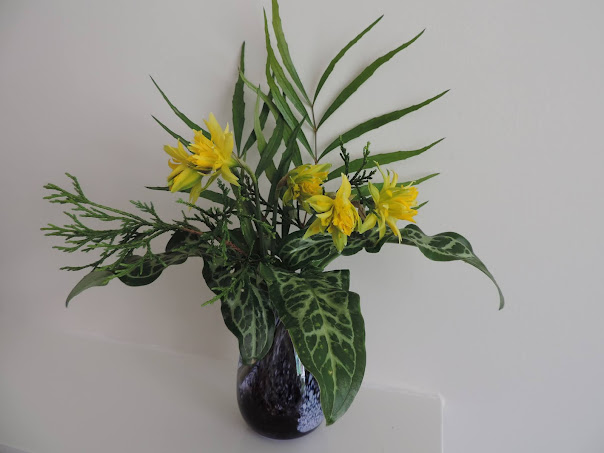1. "Beware do not plant mint" in your border warning to all new gardeners or old ones like me who did know better, but fell for the romance of mint by water. I spent a good hour trying to get all the roots out. Yes: plant it in a pot, or a bucket, but not in rich heavy clay. It was a devil of a job, and I think I shall have to watch out for missed bits coming up.
2. A new Corylus has been placed where I dug out the ice damaged Phlomis. I decided to go for a shrub which would look lovely in the spring, rather than keep on with one which I would always worry about its tolerance to low temperatures. I have a couple of that same Phlomis in another border, which can be cut back and expected to rejuvenate out of sight. In any case they were much less affected.
I had been wondering around the local nursery, with no particular plan in mind, when I was drawn to a shrub., I knew I would want to give it a go.
With the Corylus avellana Scooter the stems are more upright than a twisted hazel with with angular rather than sinuous side stems, having a kinked look with little twirly side growths, and it looks just the thing for my early spring flower arrangements. 3. During the week, it got to be too windy to sow seeds outside, and in the absence of a potting shed, the utility room was given over to the task. By writing numbers along the edge of the tray, I can keep a paper account of what is in each row of cells on the Bustaseed tray. The bottom container has no drainage holes, and with the clear domed cover, I have a little unit that can easily to moved and placed inside on the window sills. Obviouslycareful watering will be necessary.
On my recycled pot, there was room enough to write the names, as it may not be used again.
Four individual pots contain the cucumbers.
4. On one of finer days at the start of the week, I had my house plants outside, where they were inspected, preened, and had a watering from the base by standing them in a bowl of water with a diluted feed. Back on its table in the conservatory Aeonium arboreum velour is ready to face the season, having grown from this in November 2019
to this in March 2021, about 16 months, it does give one a good display. Again later this year, when it is time to bring them back from the garden, into the conservatory for the winter, the top rosette will be cut off, and planted into a gritty compost, and the rest of the plant discarded.
5. The pink primulas vulgaris, which I found growing wild on a friend's farm add that early spring splash of colour and Primula 'Wanda' are starting to flower.
 |
| Primula 'Wanda' |
I am currently enjoying a fascinating book called 'A Buzz in the Meadow, by Dave Goulson'. I managed to borrow this from our local library in time before the latest lockdown. David Goulson has a section on robbing of nectar, and gives a quote from Charles Darwin's letter to the Gardener's Chronical in 1857:
"One day I saw for the first time several large humble-bees (sic) visiting my rows of the tall scarlet Kidney Bean; they were not sucking at the mouth of the flower, but cutting holes through the calyx, and thus extracting the nectar...The very next day after the humble-bees had cut the holes, every single hive bee, without exception, instead of alighting on the left wing-petal, flew straight to the calyx and sucked through the cut hole....I am strongly inclined to believe that the hive-bees saw the humble-bees at work, and well understanding what they were at, rationally took immediate advantage of the shorter path thus made to the nectar."
I had to refer to my Collins guide to the Insects of Britain and the Western Europe. Access to the internet would yield pictures of course, but sometimes I just love to loll around with books only.
Dave Goulson's book, again with no illustrations, is a great way of getting to appreciate insects in our gardens, and should they ever meet I am sure the Prop and the author would also discuss their running: Each chapter starts with the timing of his morning run and some of his observations along the route.







































